| The American Plate Number Single Society | ||
|
HOME
MEMBERSHIP
PUBLICATIONS
LINKS
|
The First Bureau Series - 1898 issues In 1898, the Universal Postal Union set some international standards regarding colors to be used for various denominations of stamps. The lower values of the 1895 stamps were reprinted in the new colors to meet the new regulations. The U.S. followed the UPU color standards for definitive stamps for more than half a century: the 1¢ denomination was green, the 2¢ denomination red, the 3¢ denomination purple, the 4¢ denomination brown (except for the Prexy and Liberty issues), the 5¢ denomination blue, and the 10¢ denomination yellow or brown, throughout the Second Bureau issue, the Washington-Franklins, the Fourth Bureau issue, the 1938 Prexy series, and the 1954 Liberty series. USPS even held to the color scheme for the 1¢, 3¢ and 5¢ issues in the 1965 Prominent Americans series. In addition, for commemoratives from 1901 through the 1940's, the vast majority of 1¢ values were green, 2¢ values were red, 3¢ values were purple, and 5¢ values were blue.
This stamp may also win the award for "most suffixes for a catalog number!" The capital B is part of the major catalog number, required when the newly discovered Type IV needed to be inserted in the proper numbering sequence between 279 and 280, and 279a had already been assigned. The lower case j denotes the booklet pane format. The S is for the Specimen overprint. The E signifies that it is the fifth type of Specimen overprint.
The outline of the double-line watermark "S" can be seen in the selvage.
The outline of the double line watermark "U" can be seen in the selvage.
The same plate was used to print the dark blue 15¢ example of the 1895 series.
Comments? Suggestions? Email the
Webmaster:
This page last updated March 21, 2020.
|
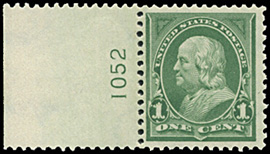 Scott
279, 1¢ Franklin, deep green,
horizontal watermark, plate number 1052
Scott
279, 1¢ Franklin, deep green,
horizontal watermark, plate number 1052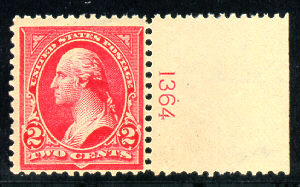 Scott
279B, 2¢ Washington Type IV, red,
plate number 1364
Scott
279B, 2¢ Washington Type IV, red,
plate number 1364 Scott
279Bc, 2¢ Washington Type IV, rose carmine,
plate number 780
Scott
279Bc, 2¢ Washington Type IV, rose carmine,
plate number 780 Scott
279Bd, 2¢ Washington Type IV, orange red, horizontal watermark,
plate number 1035
Scott
279Bd, 2¢ Washington Type IV, orange red, horizontal watermark,
plate number 1035 Scott
279Bf, 2¢ Washington Type IV, carmine,
plate number 562
Scott
279Bf, 2¢ Washington Type IV, carmine,
plate number 562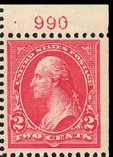 Scott
279Bj, 2¢ Washington Type IV, carmine, single from booklet pane with horizontal watermark, plate number 990
Scott
279Bj, 2¢ Washington Type IV, carmine, single from booklet pane with horizontal watermark, plate number 990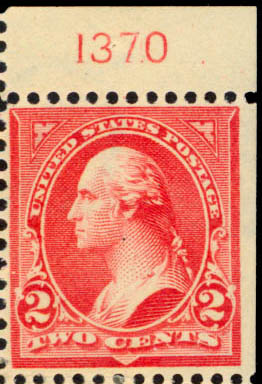 Scott
279Bk, 2¢ Washington Type IV, red, from booklet pane with vertical watermark, plate number 1370
Scott
279Bk, 2¢ Washington Type IV, red, from booklet pane with vertical watermark, plate number 1370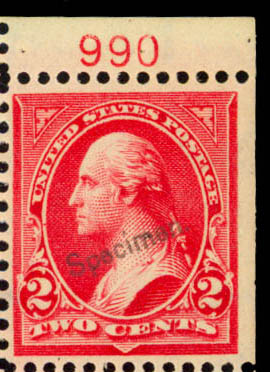 Scott
279BjSE, 2¢ Washington Type IV specimen, red, from booklet pane with horizontal watermark, plate number 990
Scott
279BjSE, 2¢ Washington Type IV specimen, red, from booklet pane with horizontal watermark, plate number 990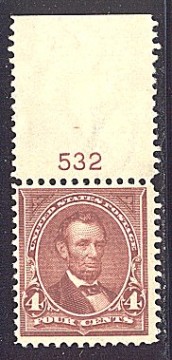 Scott 280, 4¢
Lincoln, rose brown, plate
number 532
Scott 280, 4¢
Lincoln, rose brown, plate
number 532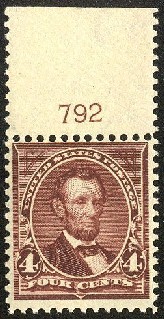 Scott 280a, 4¢
Lincoln, lilac brown, plate
number 792
Scott 280a, 4¢
Lincoln, lilac brown, plate
number 792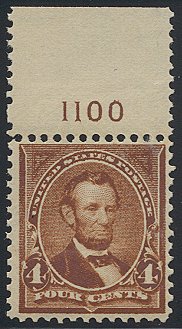 Scott 280b, 4¢
Lincoln, orange brown,
plate number 1100
Scott 280b, 4¢
Lincoln, orange brown,
plate number 1100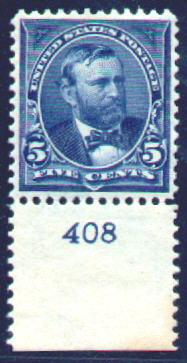 Scott
281, 5¢ Grant, blue,
plate number 408
Scott
281, 5¢ Grant, blue,
plate number 408 Scott
282, 6¢ Garfield, lake,
plate number 924
Scott
282, 6¢ Garfield, lake,
plate number 924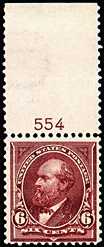 Scott
282a, 6¢ Garfield, purple lake,
plate number 554
Scott
282a, 6¢ Garfield, purple lake,
plate number 554  Scott
282 var, 6¢ Garfield, claret,
plate number 923
Scott
282 var, 6¢ Garfield, claret,
plate number 923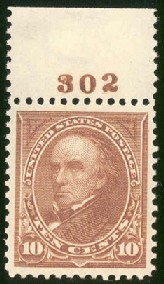 Scott
282C, 10¢ Webster, brown Type I,
plate number 302
Scott
282C, 10¢ Webster, brown Type I,
plate number 302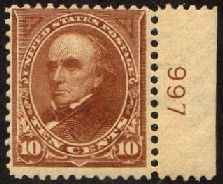 Scott
283, 10¢ Webster, brown Type II,
plate number 997
Scott
283, 10¢ Webster, brown Type II,
plate number 997 Scott
283a, 10¢ Webster, orange brown Type II, plate number 1339
Scott
283a, 10¢ Webster, orange brown Type II, plate number 1339 Scott
284, 15¢ Clay, olive green,
plate number 264
Scott
284, 15¢ Clay, olive green,
plate number 264 
